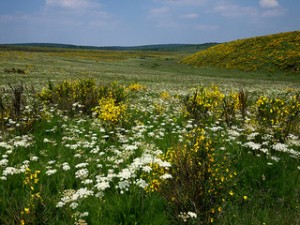- Maximizing genetic differentiation in core collections by PCA-based clustering of molecular marker data. It works. In simulations, to be fair.
- Study of rare traditional pork breeds concerning the aspect of biodiversity conservation. Mangalitsa is what you want, apparently.
- Open Variety Rights: Rethinking the Commodification of Plants. A “protected commons”? Sounds a bit like the ITPGRFA to me.
- Natural and cultural heritage in mountain landscapes: towards an integrated valuation. Yeah, but does your cultural heritage include things like agricultural biodiversity?
- Fortifying plants with the essential amino acids lysine and methionine to improve nutritional quality. Conventional breeding hasn’t worked. But has it been for want of trying? Just askin’.
- Genetic and phenotypic diversity in a germplasm working collection of cultivated tropical yams (Dioscorea spp.). Relationships among species, synonyms, duplicates, yada yada.
- Roman food refuse: urban archaeobotany in Pompeii, Regio VI, Insula 1. Romans ate a Mediterranean diet. Still no cure for cancer.
- Genetic bases of rice grain shape: so many genes, so little known. Why bother? Just askin’.
The value of Natura 2000
Speaking of return on conservation actions, which we sort of were a couple of days back:
A new study has produced the first indicative estimate of the overall economic benefits provided by the Natura 2000 network. It suggests that the value could be currently between €200 and €300 billion per year, or 2% to 3% of the EU’s Gross Domestic Product.
That’s from one item in a special Thematic Issue of the European Commission’s news alert organ Science for Environment Policy which focuses on “Management and Monitoring of the NATURA 2000 Network,” (pdf) a network of protected areas that is described in the editorial introducing the issue as the “cornerstone of EU biodiversity policy.”

- What does ‘wilderness’ mean?
- First EU-wide economic valuation of Natura 2000 network
- Improved local management needed for the Natura 2000 network
- Natura 2000 Case Study Hoge Kempen: from coal mining landscape to oasis of biodiversity
- Improved communication about Natura 2000 may help resolve landowner conflicts
- Ecotourism: protecting the nature of Natura 2000 in Latvia
- Natura 2000 Case Study Slitere National Park: sustainable tourism in a Natura 2000 site
- Natura 2000 Case Study Eurosite – Adaptive Management of Natura 2000 sites
- Protected areas act as stepping stones for nature in the face of climate change
- New Belgian approach to favourable conservation status for habitats and species of European interest
- Sustaining the Natura 2000 network through LIFE
We’ve talked before about Natura 2000 in the context of conservation of crop wild relatives. I’m willing to bet that return on investment doesn’t take into account any species important in crop improvement that the network happens to be protecting. But if you know better, let us know.
Nibbles: Survival seeds, Turkish agrobiodiversity, Mainstreaming nutrition, Hot times for conservation, Ethiopian sesame, Conserved DNA
- Survival seed bank in the news again. Must be Christmas.
- Turkish nibbles: wine, pictachios. That wine one will no doubt run and run.
- How to make sure nutrition gets a seat at the agricultural development table. And Danny breaks it down for ya.
- What leads to spurts in conservation effort? In situ only, but instructive.
- Sesame is big business in Ethiopia.
- Boffins find yet another bit of DNA that will save the world.
Nibbles: Sesamum publications, Organic China, Melaku Worede biopic, Pre-breeding smackdown, Price of spice, Pineapple breeding
- A bibliography of sesame. Good to have.
- All you want to know about organic farming in China. Who knows when it might come in useful.
- The legacy of Melaku Worede. Proud to know him.
- European pre-breeding meeting. Would be good to go.
- The Spice Trade 2.0. Good gig if you can get it.
- Coconut-tasting pineapple. Why?
Brainfood: Bumper bonanza, Old peas, Irrigated meadows, Cereal mashes, Medicinal plants, Diversity and production, Millet gaps, Seed ageing, Flax core
- First off — a pretty big deal. Taylor & Francis have made a bunch of papers related to sustainable agriculture freely available, but only until the end of December. Happy whatever holiday won’t offend you.
- Twentieth-century changes in the genetic composition of Swedish field pea metapopulations. Metapopulations have become isolated populations. In genebanks.
- Effects of different irrigation systems on the biodiversity of species-rich hay meadows. Change from the traditional irrigation system has affected biodiversity levels, but not a huge amount.
- Research regarding the use of wheat biodiversity for obtaining some cereal-based fermented mashes. Let’s go straight to what we need to know here: the best mash come from spelt wheat. Oh, to be the one doing the organoleptic characterization.
- Cultivation and high capitalization of medicinal and aromatic plants in the Romanian-Bulgarian cross-border region. If you’re really interested, there’s a database that brings it all together.
- Crop biodiversity, productivity and production risk: Panel data micro-evidence from Ethiopia. More crops = more production. But the devil is in the details, I suspect.
- Identification of gaps in pearl millet germplasm from East and Southern Africa conserved at the ICRISAT genebank. We used to do this sort of thing by hand in my day.
- At3g08030 transcript: a molecular marker of seed ageing. This mRNA could predict germination performance of a dry seed lot across species. Good for genebanks?
- Assembling a core collection from the flax world collection maintained by Plant Gene Resources of Canada. You don’t hear much about core collections these days, why is that?